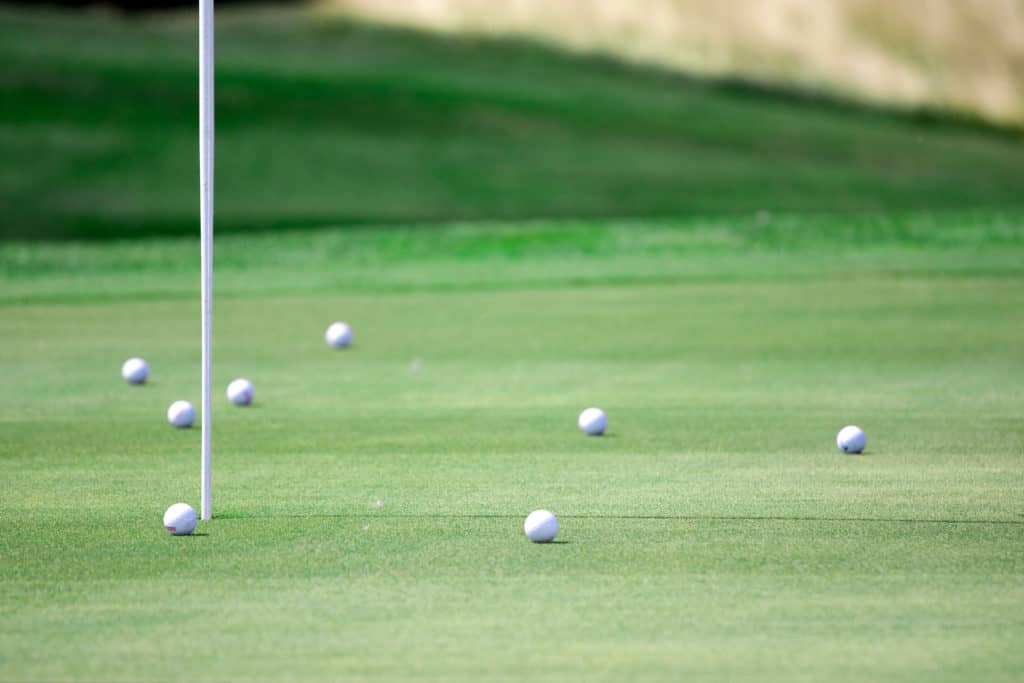Does this scenario sound familiar?
You hit a quality drive down the middle, stick the green with your approach shot and then end up 3 putting.
Or you hit a great chip shot to 3-4 feet and pull your putt to the left and you leave the green with a bogey or worse.
Golf, especially when it comes to the short game, can be frustrating. There are many variables when putting such as green speed, the undulation in the green and the hole location. On those days we are striking the ball well, we want to capitalize on our opportunities on the green.
As to not drive ourselves crazy or turn to anger, we assess the quality of our shots based on our ability to hit the ball at a quality pace on our intended start line.
When putting, there are certain things we can control and certain things we can’t control. Ultimately, the golfer can control 3 things:
- The aim
- The start line
- The speed
Why Am I Pulling My Putts Left?
The golfer is typically making one of the following common errors:
- They are aiming to the left
- They don’t trust their line and over compensate
- They are taking the putting motion out and across the ball
- The ball is too far forward in their stance
The reasons are pretty basic, but can be difficult to understand exactly the problem at hand. As a results, we would recommend returning to the basics, getting on a putting green and going through the following process.

How To Stop Pulling My Putts Left
The golfer will want to follow the steps detailed below to get their putting back on on track. We recommend the 3 steps below:
- Ensure you are aiming where you are intending to aim
- Work on your start line
- Practice your pace
Keep in mind, we want to assess our putting based on our ability to aim, to hit our start line and to hit the ball a quality pace.
Step #1: Ensure you are aiming where you are intending to aim
Too many golfers step behind their ball, look at the putt and then step up to their putt and aim way too far left or right of their intended line.
Here is a process you can go through:
- Read the break in the putt
- Determine where you want the ball to start
- After drawing a line on your golf ball, aim that line at your intended start line
- Go back behind the ball and check to see if you aimed where you intended
- Get over the putt and trust that line, you eyes will try to play a trick on you, but trust your line.
Quick Tip: If you squat down behind the ball, close one eye and use your putter shaft to see if your line is aiming where you intend to aim. You want to line the putter shaft up along the line about a foot in front of your open eye.
Aiming is half the battle in putting. If you can read the green and aim properly, you are well ahead of 75% of amateurs playing the game of golf.
Pushing putts to the right? (3 Solutions)

Step #2: Work on your start line
Now that we have ensured you are aiming properly, let’s focus on the start line. The golfer will read the green, aim their golf ball and then focus on starting the ball down that line.
Here is a process you can go through:
- On the practice green, find a 10 foot putt that has a slight break in it.
- Go ahead and get the aim point and determine where you want to start the ball.
- Once you have determined that is the correct line, place two tees just outside the edges of the putter and create a gate for the putter to pass through.
- Go through your aim process with the line and work on squaring up the putter face to send the ball down the intended start lie.
- You could hit putts here for an extended time, working on your aim and your start line control.
Short putter vs Long putter (Which one should I use?)

Step #3: Practice your pace
The right pace on a putt can make up for a poorly read putt on the longer putts. If you are putting from 30 feet and have a poor line and poor speed, chances of 3 putting are increased. However, even if you misread the putt, but hit the ball at a decent pace, you can still be within 3 feet of the hole for a relatively simple putt.
Here is a drill I would recommend:
- From 30-40 feet, try to hit 5 putts inside of 3 feet.
- Go ahead and repeat this assessment 5-6 times per practice session.
- Change up your distance from the hole from assessment to assessment.
On those longer putts during a round, it is fine to take a little extra break to help with the pace and to ensure the ball doesn’t completely run away from you if you miss on the low side.

Final Thoughts: Have Realistic Expectations
What percentage of putts from 8 feet do you think are made on the PGA Tour?
If you guessed 50%, you are right. Think about that for a moment, even the best golfers on the planet are only making 50% of their putts from 8 feet. But I bet every time you stick an approach shot to 8 feet, you expect to make the birdie putt.
There are some keys areas you want to practice from:
- Work on those 5-10 footers.
- Work on 30 foot putts for 3 putt avoidance.
There isn’t much difference in the 20 foot range among different levels of golfers, but get inside of 10 feet or outside of 30 feet and big differences are found through the analytics.
My Secret To Golf Improvement
Let’s face it, in order to get really good at golf, we must practice frequently. About give years ago, I made the leap and invested in a golf simulator build for my garage. I went with a SkyTrak Launch Monitor and the TGC software and can now play over 100,000 courses including Augusta, Pebble Beach, Bethpage Black, Whistling Straits. St. Andrews and many other of the top 100 courses in the world.
This golf simulator setup, which is more affordable that you might imagine, has been a game changer. I can now play golf everyday of the year regardless of rain, snow, cold weather or time of day. I can practice or play rounds of golf. I can stand in the 11th fairway at Augusta and with the auto-rewind feature I am able to practice my approach shots from various differences.
It is worth checking out through Rain or Shine Golf as they offer some incredible packages along with financing offers that are difficult to beat.
Some direct links to Rain or Shine Golf for pricing and financing:
I am an amateur golfer on a journey to get better, enjoy the game as often as possible and share my passion and knowledge with others. I have coached high school golfers at a high level and have a great passion for the game and want to give back. I enjoy learning about the golf swing and am currently studying to be a certified professional golf instructor. Join me in our journey to get better everyday.

